
| What is Flavor and Fortune? |
| How do I subscribe? |
| How do I get past issues? |
| How do I advertise? |
| How do I contact the editor? |
Read 12714740 times
Connect me to:
| Home |
| Articles |
| Book reviews |
| Letters to the Editor |
| Newmans News and Notes |
| Recipes |
| Restaurant reviews |
| Article Index (all years, slow) |
| List of Article Years |
| Article Index (2025) |
| Article Index (last 2 years) |
| Things others say |
| Related Links |
| Log In... |
| Authors |
| Categories & Topics |
Eggs Of Many Kinds
| by Jacqueline M. Newman |
Eggs
Winter Volume: 2012 Issue: 19(4) page(s): 28 - 30, and 36
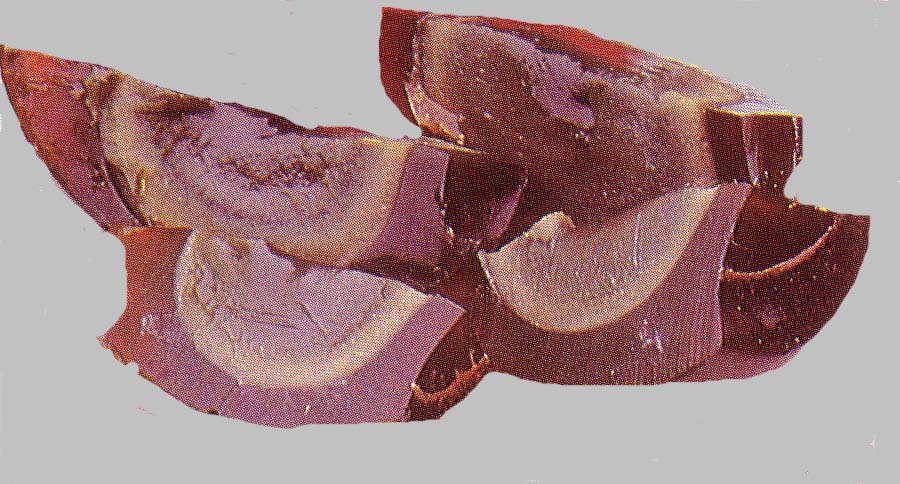 Stories abound about eggs for self, for guests, for immortals, or for dragons. Do you know the one about the cook who prepares them for guests and overcooks them? Then, to appease his angry employer, he removes the overcooked hard yolks and stuffs the holes left in the whites with minced meat. he then seals them with a cornstarch paste and steams them. When pressed for the name of the recipe, since he prepared eight eggs, he declares these items: Eight Immortal's Eggs; and the name of this dish continues to this day. Then there is a recipe called Dragon Eggs said to be eggs from baby alligators, snakes, or other reptiles. Bet you know other egg tales.
Stories abound about eggs for self, for guests, for immortals, or for dragons. Do you know the one about the cook who prepares them for guests and overcooks them? Then, to appease his angry employer, he removes the overcooked hard yolks and stuffs the holes left in the whites with minced meat. he then seals them with a cornstarch paste and steams them. When pressed for the name of the recipe, since he prepared eight eggs, he declares these items: Eight Immortal's Eggs; and the name of this dish continues to this day. Then there is a recipe called Dragon Eggs said to be eggs from baby alligators, snakes, or other reptiles. Bet you know other egg tales.
Eggs are fascinating, and many cultures use them as fertility symbols. The Chinese believe eggs a perfect balance of foods with five virtues. They also speak of the white as yin, the yolks as yang; and those five virtues as: kindness, properness, purity, wisdom, and truth. But what kinds of eggs do they mean?
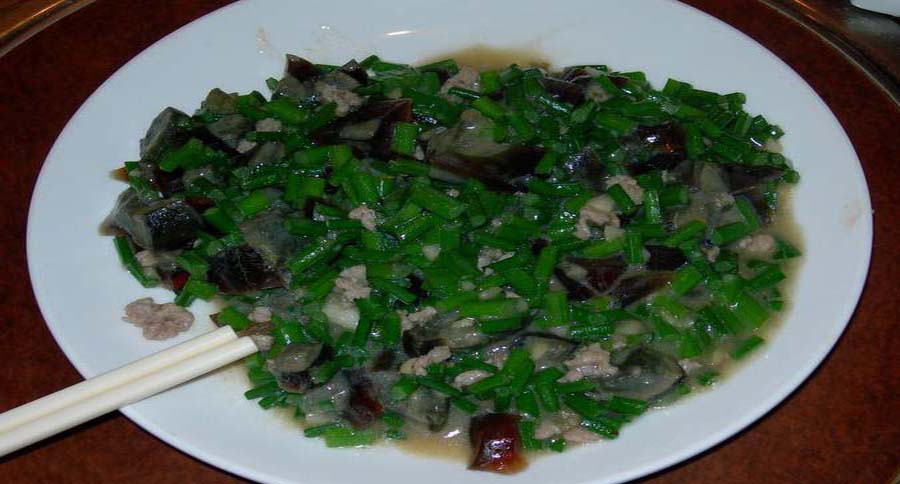 Westerners most often eat chicken eggs. The Chinese do eat chicken eggs but prefer duck eggs, pigeon eggs, and turtle eggs. They also eat eggs from many other animals and even make some dishes with more than one kind of egg. Examples include their Three Colored Eggs, and their Gold and Silver Eggs, too. Most unusual, they also use eggs that are not fresh and eggs out of their shells.
Westerners most often eat chicken eggs. The Chinese do eat chicken eggs but prefer duck eggs, pigeon eggs, and turtle eggs. They also eat eggs from many other animals and even make some dishes with more than one kind of egg. Examples include their Three Colored Eggs, and their Gold and Silver Eggs, too. Most unusual, they also use eggs that are not fresh and eggs out of their shells.
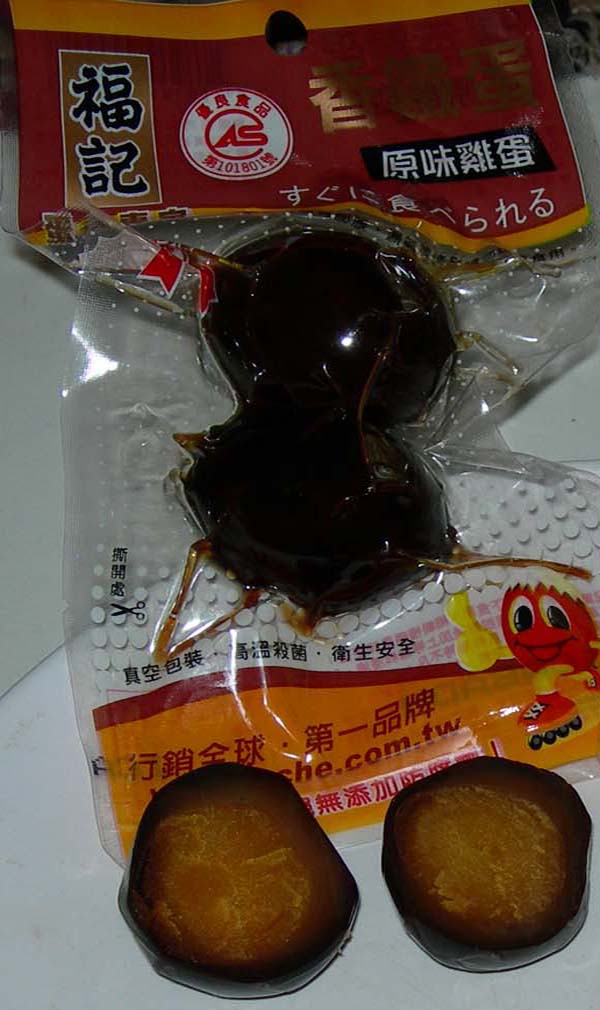 Duck eggs are most often prepared brined in a salt solution for about thirty days. They also use eggs treated with lime and with other minerals. Both of these treatments increase the shelf life of the eggs and change their flavor. The latter ones look black and hard cooked, but are not cooked at all. The salted ones look partially cooked with an intense, almost orange-colored yolk, their white still a clear liquid. The dark eggs that are really greenish-black are not cooked even though they look like they were. Most often, they are preserved in lime, ash, and other things, and they can be eaten as soon as they are peeled. The brined ones should never be eaten raw because they can have a high bacteria count; they must be cooked. In the United States, most now are before being sold.
Duck eggs are most often prepared brined in a salt solution for about thirty days. They also use eggs treated with lime and with other minerals. Both of these treatments increase the shelf life of the eggs and change their flavor. The latter ones look black and hard cooked, but are not cooked at all. The salted ones look partially cooked with an intense, almost orange-colored yolk, their white still a clear liquid. The dark eggs that are really greenish-black are not cooked even though they look like they were. Most often, they are preserved in lime, ash, and other things, and they can be eaten as soon as they are peeled. The brined ones should never be eaten raw because they can have a high bacteria count; they must be cooked. In the United States, most now are before being sold.
Best known as hundred-year-eggs, the reality is these almost black eggs are lots younger than that. Most often they are preserved for about one hundred days. They have been mentioned in earlier articles, so do check them out in every earlier Index listing at Flavor and Fortune’s website, that is www.flavorandfortune.com Used to be there was no heading for eggs, but we have changed that due to many requests for same. That means look under 'eggs' and look item by item ib many other sections. In the future we will put recipes using eggs in this, their own location.
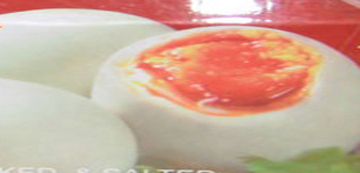 Most of the brined or buried eggs are made using duck eggs. A smaller number of recipes use the same process but for a shorter time frame for pigeon and other smaller eggs preserved the same way. In Taiwan, they make something called 'iron eggs.' We discovered them on a trip to Taiwan, and they too, can be checked out separately. The brined or buried eggs change their features physically and chemically. The white or albumin part and the yellow or yolk part looks different, smell different, and taste different. These treatments prolong their shelf life and widen their audience.
Most of the brined or buried eggs are made using duck eggs. A smaller number of recipes use the same process but for a shorter time frame for pigeon and other smaller eggs preserved the same way. In Taiwan, they make something called 'iron eggs.' We discovered them on a trip to Taiwan, and they too, can be checked out separately. The brined or buried eggs change their features physically and chemically. The white or albumin part and the yellow or yolk part looks different, smell different, and taste different. These treatments prolong their shelf life and widen their audience.
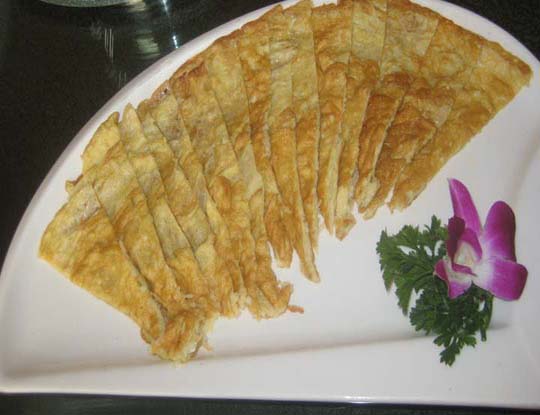 Historians believe these treatments began some time around the beginning of the Ming Dynasty (1368 CE). Nowadays, in Chinese and Asian markets, one sees various kinds of them packed in cardboard egg containers, some in the cold sections, others in room-temperature places. When you take them home, do refrigerate them. The black ones used to be covered with rice hulls usually a quarter of an inch thick and sold from large ceramic urns later often used for potted plants. All of these eggs, to be shelf-stable, need a month or more to change and, should you make any, though most Chinese purchase theirs, do not eat them for a month or more after that.
Historians believe these treatments began some time around the beginning of the Ming Dynasty (1368 CE). Nowadays, in Chinese and Asian markets, one sees various kinds of them packed in cardboard egg containers, some in the cold sections, others in room-temperature places. When you take them home, do refrigerate them. The black ones used to be covered with rice hulls usually a quarter of an inch thick and sold from large ceramic urns later often used for potted plants. All of these eggs, to be shelf-stable, need a month or more to change and, should you make any, though most Chinese purchase theirs, do not eat them for a month or more after that.
The dark-colored ones are called pidan. Some manufacturers now dip them in wax, we prefer purchasing ours without the wax, which if consumed, can be carcinogenic. Those prepared in brine are called xiandan, and those pickled are called zaodan. You guessed, it, dan does mean egg.
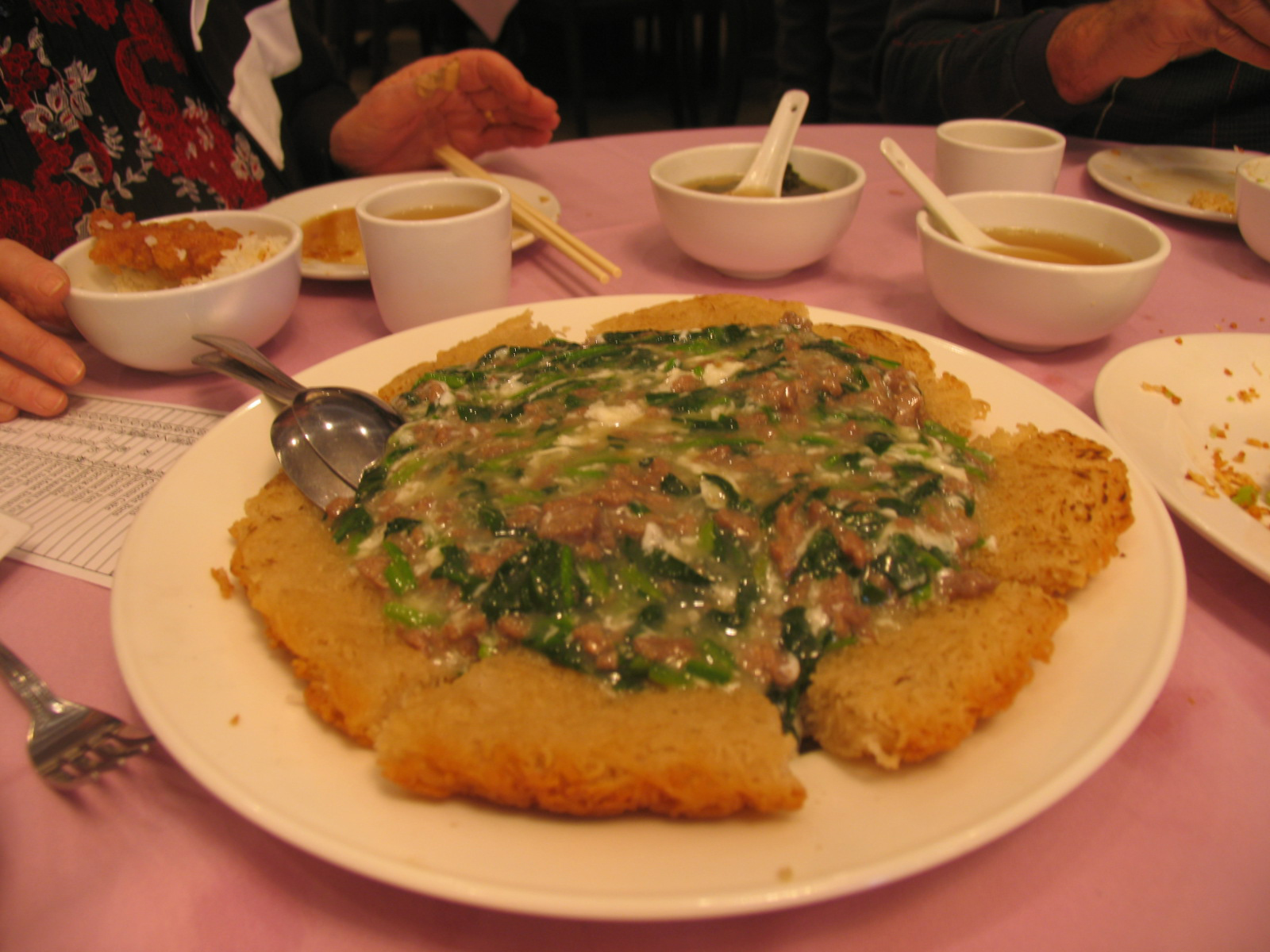 Chinese medical practitioners advise that duck eggs are not suitable for those with insufficient spleen-yang, those with diarrhea due to cold-dampness, those suffering with too much flatulence, or those with nausea after eating. They also advise those with kidney disease should not to eat these eggs.
Chinese medical practitioners advise that duck eggs are not suitable for those with insufficient spleen-yang, those with diarrhea due to cold-dampness, those suffering with too much flatulence, or those with nausea after eating. They also advise those with kidney disease should not to eat these eggs.
These practitioners believe duck eggs are sweet in nature, cool, nourish the yin, clear the lungs, and cure sore throats, toothaches, and coughs due to heat. All kinds of fresh eggs are good for new mothers; and they recommend them in large numbers to replenish qi and to ingest more calories because duck eggs, in particular, are fattier than chicken eggs.
Pidan eggs, these days, are classified by whether the yolk is semi-solid or totally firm. Semi-solid ones have a more pleasant aroma and taste, with no after-taste. Those with semi-solid yolks are less salty and have lower alkalinity. They also often can contain a small amount of lead oxide.
Xiandan eggs, the salted or brined ones, need that month before consuming them, Not all are soaking in brine, some are in a salt-paste. Almost all of them are ready to eat after twenty-five or so days, and always after they are cooked.
Zaodan or pickled eggs are made in a grain mash with their shells cracked, the membranes under the shell left in tact. They are put on that mash in a single layer, more mash put on top, then some salt put over that. These eggs remain some four or more months, and readily drop their shells when cracked. Surprisingly, they smell sweet, while the thousand year eggs smell from ammonia. These eggs can be eaten cooked or uncooked.
The recipes below offer variety in egg cookery. In keeping with the recipe called Eight Immortal's Eggs, there are eight recipes below. Eight is a lucky number to the Chinese. Do not eat them all in the same week. During Ming Dynasty times, typical families might have only eight eggs per person in an entire year. Modern health practitioners suggest limiting egg consumption if using them for foaming or leavening, binding, setting or coagulating, emulsifying, tenderizing, flavoring, clarifying, or coloring of foods, and they suggest a maximum of two eggs a week, so try these recipes over a few weeks.
When you do, keep in mind that extra-large eggs or duck eggs have more than four tablespoons of egg, large ones each have a mite more than three tablespoons. When purchasing yours, looking for large ones does make little sense, look for heavy ones. Pick up several containers and select the heaviest among them.
| Tea Eggs |
|---|
1/4 cup soy sauce 1/4 cup granulated sugar 4 whole cloves 1/2 teaspoon fennel seeds 1/2 teaspoon whole black peppercorns 3 whole star anise 2 sticks Chinese cassia or cinnamon 1 tea bag of any smokey tea such as lapsang soushong 5 chicken eggs 20 ice cubes Preparation: 1. In a two-quart pot, add two cups of water and the soy sauce, sugar, cloves, fennel seeds, peppercorns, star anise, and the cinnamon sticks. Tear the tea bag open and add the tea leaves to the liquid. Bring this to the boil, reduce the heat and simmer for fifteen minutes. Then strain and discard the solids. 2. In another small pot, put in the eggs, then two cups of cold water. Bring to just below the boiling point, reduce the heat, and simmer the eggs for ten minutes. Then take them out and discard the water. Use a pot holder and gently roll the eggs just until the eggs begin to crack. Do not break the membranes, just the shells, and do not peel the eggs. 3. Put the strained liquid into the pot with the eggs, and bring to the boil, reduce the heat somewhat, and simmer for eight minutes. Next, steam the eggs for twenty minutes. Peel the eggs, and serve. |
| Fried Vegetable Omelette |
|---|
1 zucchini or 1 carrot, shredded; or one-half of each 1 Tablespoon vegetable oil 4 eggs, beaten 1 teaspoon salt or 1 Tablespoon thin soy sauce Preparation: 1. Put shredded vegetable(s) and the oil in a wok or fry pan, and stir-fry until they are soft. 2. Add salt to the beaten eggs, then add them to the wok or fry pan and stir-fry until the eggs begin to set. Fry them fry until golden, and serve. |
| Three-color Diamond Delicacies |
|---|
1 Tablespoon chicken fat 1/4 pound chicken breasts, thinly sliced 1/2 pound shrimp, peeled, veins removed, and chopped>br> 5 Tablespoons pork fat, ground 1 teaspoon salt 1 Tablespoon cornstarch 1 tablespoon Chinese rice wine 5 egg whites, beaten until just before they become stiff 3 Tablespoons spinach leaves, coarsely minced 1 slice Yunnan am, cut into small diamond shapes Preparation: 1. Pour chicken fat on a small heat-proof baking tray and put a single layer of chicken breast meat on it. 2. Mix shrimp, prk fat, salt, cornstarch, and wine and spead on top of the chicken, then put this on a steamer tray over rapidly boiling water and steam for three minutes. 3. Spread the beaten egg whites over the prawn mixture, and steam for sevem more minutes. 4. Loosen the bottom of the chicken pieces and cut into one-inch diamond-shaped pieces. Put them on a heat-proof plate, top each piece with a piece of ham, steam another three minutes, then serve. |
| Gold and Silver Eggs |
|---|
1 Tablespoon vegetable oil 1 clove peeled garlic, minced 2 salted duck eggs, coarsely diced 2 thousand year eggs, coarsely diced 1 Tablespoon granulated sugar 1 tablespoon cornstarch mixed with three tablespoons cold water 1 cup hot steamed rice, spread around an eight-inch soup bowl Preparation: 1. Heat wok or fry pan, add the oil, and stir-fry the garlic for one minute, then add one cup of boiling water and the sugar and stir before adding the eggs. 2. Simmer for four minutes before adding the cornstarch mixture, then stir until thickened. Pour over the rice, and serve. |
| Eight Immmortals' Eggs |
|---|
8 large eggs 1/4 pound minced pork 2 Tablespoons Chinese rice wine, divided inhalf 2 Tablespoons thin soy sauce, divided in half 1 teaspoon salt, divided in half 3 Tablespoons minced fresh ginger 1 Tablespoon cornstarch mixed with two tablespoons cold water 2 cups oil 1/2 cup chicken broth 1 Tablespoon granulated sugar Preparation: 1. Simmer the eggs for ten minutes, then soak them in cold water to cool them. when cool gently roll them and then peel removing all the shell. Next, cut them in half and set yolks aside for another use. 2. Mix pork, rice wine, soy sauce, salt, and ginger and fill both halves where the yolks were. Brush a little cornstarch over the whites and the fillings and paste the eggs together matching correct halves together. Let them rest fifteen minutes. 3. Brush some cornstarch mixture over the egg exteriors and steam for five minutes over boiling water. 4. Heat oil in a small pot and deep-fry half the eggs until golden, then remove them to paper towels. Deep-fry the other half of them doing the same, and then put all the eggs on a deep platter. 5. Heat chicken broth with any remining cornstarch mixture, bring to the boil. and when thickened, pour over the eggs, and serve. |
| Quail Egg Dumpling Soup |
|---|
6 ounces finely minced or ground pork 1 Tablespoon thin soy sauce 2 teaspoons Chinese rice wine 1/2 teaspoon salt 1/2 scallion, green part only, minced, divided 1 teaspoon minced fresh ginger, divided 25 meat or wheat dumpling skins* 2 quarts chicken stock Preparation: 1. Mix pork, soy sauce, rice wine, salt, half the minced green scallion, and half the minced ginger root. 2. Lightly dampen half a dumpling skin, and make a dumpling putting one teaspoon of the meat mixture in each skin, wet the edges and all areas where there is no meat. Fold and seal the meat in, pushing any air out. Put the dumpling on a plate, make the next one, and do not allow the dumplings to touch each other. Let the dumplings rest half an hour. 3. Bring the stock and the remaining ginger to the boil, and add the dumplings and when they float to the top, add the rest of the minced scallion, then serve. Note: Meat skins, called yan pi, are available in some Chinese markets, particularly those servicing large numbers of Fujianese and/or Taiwanese customers. |
| Thousand-year Eggs on Mung Bean Noodles |
|---|
3 thousand-year eggs, peeled, rinsed, ans minced 1/2 teaspoon coarse salt 1 teaspoon granulated sugar 1 teaspoon sesame oil 1 Tablespoon Chinese rice wine dash ground white pepper 3 ounces wide mung bean noodles, soaked, then cut into two-inch lengths 1/2 scallion, green part only, minced 1 Tablespoon pork floss Preparation: 1. Mix eggs with salt, sugar, sesame oil, rice wine, and ground pepper, and set aside for ten minutes. 2.Put mung bean noodles into a pot of boiling water, and when they change and become transparent, remove and rinse them in ice cold water. Then dry them somewhat on a dish towel and put them on a serving plate. 3. Top the noodles with the thousand-year egg mixture, and sprinkle them with the minced scallion and the pork floss. Then serve. |
| Meat in Egg Wrapper |
|---|
10 ounces peeled shrimp, veins removed and discarded, then finely minced or ground pork 2 Tablespoons chicken fat, frozen, then minced 4 eggs, three whole, one separated 1/2 teaspoon Chinese rice wine 1/2 teaspoon chicken bouillon powder some ten-inch squares of freezer paper 3 Tablespoons vegetable oil 3 seaweed sheet pieces, each cut in half 1 piece of endive or curly lettuce, cut in half Preparation: 1. Beat two eggs and two yolks together. 2. Heat fry pan, brush with some oil, then pour some of the beaten eggs and thinly coat the pan, pouring out any extra. Once this thin egg pancake is set, gently ease it onto a piece of freezer paper, glossy side up. Repeat, putting each pancake on its own piece of freezer paper. Repeat until all egg mixture is made into six or more pancakes. 2. Mix minced shrimp or the meat, chicken fat, one egg white, rice wine, and the bouillon powder. 3. Spread each egg pancake with some of the shrimp mixture, top with a sheet of seaweed, and add another layer of the shrimp on top of it. Roll both sides to the middle, and put them near each other but not touching on a heat-proof plate. 4. Cover with plastic wrap or a microwave cover, and on medium high, microwave for six minutes. Put half lettuce leaf on each end of the plate. Then cut rolls of egg into half-inch slices and put them on a small plate and serve. |
| Tea Eggs |
|---|
1/4 cup soy sauce 1/4 cup granulated sugar 4 whole cloves 1/2 teaspoon fennel seeds 1/2 teaspoon whole black peppercorns 3 whole star anise 2 sticks Chinese cassia or cinnamon 1 tea bag of any smokey tea such as lapsang soushong 5 chicken eggs 20 ice cubes Preparation: 1. In a two-quart pot, add two cups of water and the soy sauce, sugar, cloves, fennel seeds, peppercorns, star anise, and the cinnamon sticks. Tear the tea bag open and add the tea leaves to the liquid. Bring this to the boil, reduce the heat and simmer for fifteen minutes. Then strain and discard the solids. 2. In another small pot, put in the eggs, then two cups of cold water. Bring to just below the boiling point, reduce the heat, and simmer the eggs for ten minutes. Then take them out and discard the water. Use a pot holder and gently roll the eggs just until the eggs begin to crack. Do not break the membranes, just the shells, and do not peel the eggs. 3. Put the strained liquid into the pot with the eggs, and bring to the boil, reduce the heat somewhat, and simmer for eight minutes. Next, steam the eggs for twenty minutes. Peel the eggs, and serve. |

Copyright © 1994-2025 by ISACC, all rights reserved
Address
3 Jefferson Ferry Drive
S. Setauket NY 11720